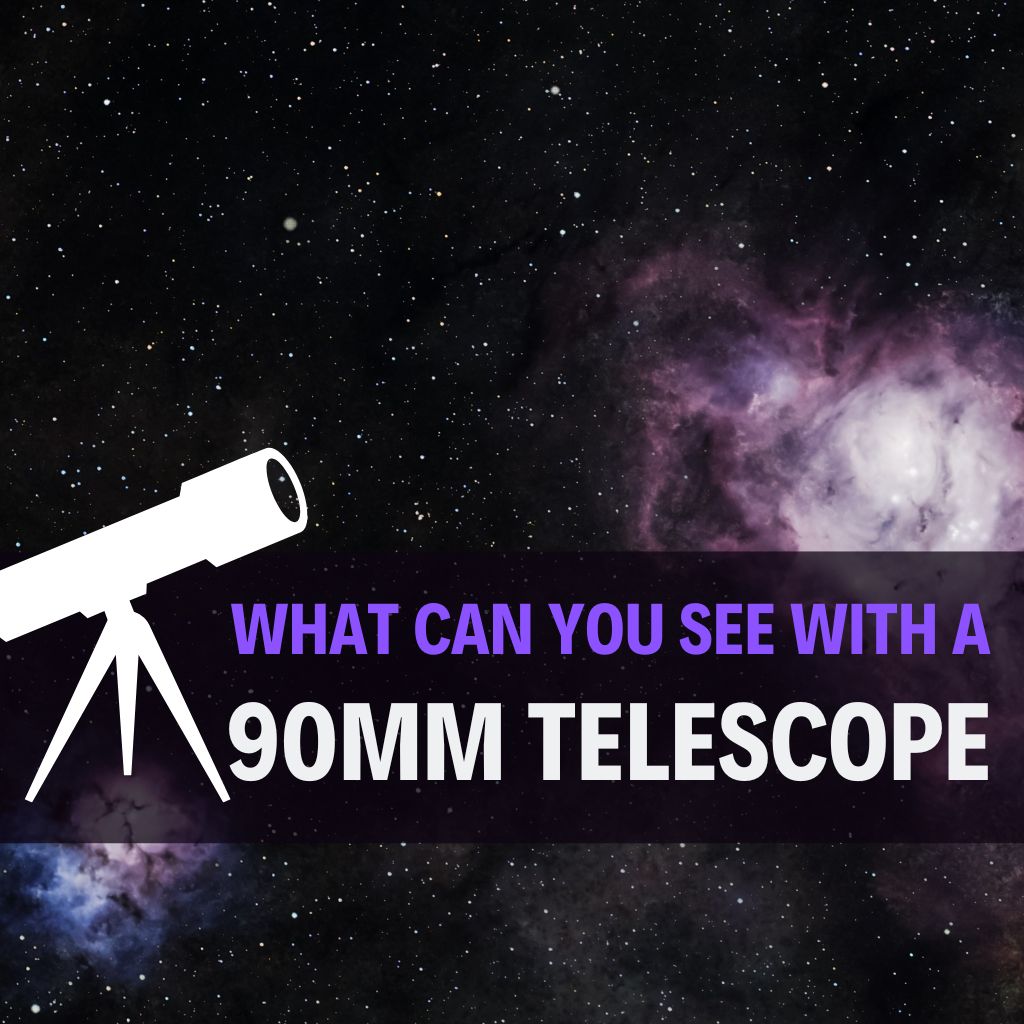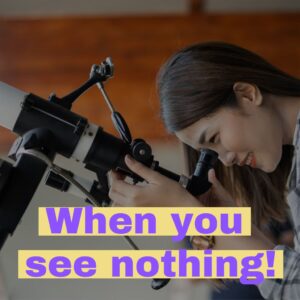This site contains affiliate links to products. I may receive a commission for purchases made through these links.
With a 90mm telescope, you can see a diverse range of celestial objects, including planets, stars, galaxies, and nebulae. You can also utilize this telescope for conducting observations of terrestrial subjects.
If you’re an aspiring stargazer, an astronomy enthusiast, or simply someone with an insatiable curiosity about the universe, you can embark on this journey with a 90mm telescope.
This remarkable optical instrument offers a glimpse into the celestial realm, revealing captivating astronomical objects.
This article will delve into the possibilities that unfold when you wield a 90mm telescope.
What objects can I see with a 90mm telescope?
Here are some objects you can view with a 90mm telescope:
Solar system objects
A 90mm telescope is a great tool for exploring the night sky. With it, you can view a variety of objects within our solar system, such as:
The Moon
The lunar surface is a perfect target for a 90mm telescope. You can observe lunar craters and other fine details on the Moon’s surface. The experience is significantly better than what the naked eye can provide.
Planets
You can observe details on the planetary disk of Jupiter and its Galilean moons, the ring system of Saturn along with the Cassini division, the phases of Venus, and even the polar ice caps on Mars under good atmospheric conditions.
Sun
You can see solar flares with a proper solar filter, which is quite an incredible sight.
Deep sky objects
Even though a 90mm telescope is a small telescope, you can still explore some deep sky objects under dark skies away from light pollution.
Planetary nebulae
These bright objects, such as the Dumbbell Nebula, can be seen with your 90mm telescope. Though the view might not be as detailed as through larger apertures, these nebulae still offer an incredible sight.
Star clusters
Star clusters, both globular clusters like M13 in Hercules and open clusters such as the Double Cluster in Perseus, can be seen with a 90mm telescope. These clusters of stars provide captivating images.
Galaxies
The Andromeda galaxy and Bode’s galaxy are examples of galaxies that can be viewed with a 90mm telescope. They may appear as faint smudges of light, but it’s an amazing experience knowing you are observing distant galaxies!
Comets and asteroids
These visitors from the outer parts of our solar system can often be seen with a 90mm telescope when they are at their brightest.
Can I view Jupiter with a 90mm telescope?
With a 90mm telescope, you can view Jupiter and its atmospheric bands. Jupiter’s four largest moons, known as the Galilean moons, are also visible as tiny pinpricks of light.
The experience will be much more fulfilling in a dark location away from city lights.
Is a 90mm a good telescope aperture?
A 90mm telescope aperture is a good mid-range size. It offers a balance between portability and optical performance. It’s small enough to be portable but large enough to provide clear images of various astronomical objects.
When choosing a telescope, the size of the aperture is an important factor. The aperture is the diameter of the telescope’s optical tube and defines how much light it can gather. A larger aperture usually allows you to see fainter and more distant objects.
A 90mm aperture has the ability to gather 165 times more light than the naked eye. This means you’ll be able to see objects much dimmer than you can see unaided. It also provides a reasonable resolution, allowing you to see fine details on the lunar surface and planetary disks.
It is relatively compact and lightweight. This makes it easier to transport to dark locations away from city lights, where observing deep-sky objects like galaxies and nebulae becomes possible.
The 90mm telescope can be used for both planetary and deep sky observing. It’s a good size for viewing bright globular clusters, planetary nebulae, and some of the brighter galaxies.
However, it’s essential to remember that while a 90mm telescope is a good telescope, it does have its limits. Larger aperture telescopes, under dark skies, will reveal more detail and fainter objects.
You may also like: What Is a Good Aperture for a Telescope?
Is a 90mm telescope good for astrophotography?
A 90mm telescope and a good quality webcam-type camera can be used for astrophotography, particularly planetary and lunar photography.
Even fine details such as Jupiter’s cloud bands, Saturn’s ring system, or lunar craters can be captured with patience and good atmospheric conditions.
However, the astrophotography of deep sky objects with a 90mm telescope is more challenging. These objects are generally much dimmer, and capturing their faint light requires long exposure times.
To achieve these long exposures, you will need a telescope mount capable of accurately tracking the stars’ motion across the sky, such as an equatorial mount.
In addition, while a 90mm aperture can gather enough light to capture images of brighter deep sky objects like the Orion Nebula or the Andromeda Galaxy, many globular clusters and other galaxies will appear faint or even invisible due to the smaller aperture.
Advantages of a 90mm telescope
A 90mm telescope has several advantages, making it a good choice for beginners and more experienced observers.
Here are some of them:
Accessibility
Due to its relatively small size and weight, a 90mm telescope is more accessible and easier to handle than larger telescope models. This makes it a great option for young astronomers, beginners, or anyone who values portability.
Cost-effective
The price of a telescope typically increases with the size of the aperture. Thus, a 90mm telescope tends to be more affordable than larger models. This is especially beneficial for beginners who might not be ready to invest heavily in a large telescope.
Versatility
A 90mm telescope can be used to observe a variety of objects, from lunar and planetary features to brighter deep sky objects. This makes it a versatile tool for astronomy.
Good for basic astrophotography
Though a 90mm telescope may not be the best choice for advanced deep sky astrophotography, it is still suitable for basic astrophotography, especially for capturing images of the Moon and the planets of our solar system.
Limitations of a 90mm Telescope
Despite the advantages, a 90mm telescope also comes with its share of limitations.
Here are some downsides to consider:
Limited light-gathering capacity
The 90mm aperture, while suitable for many celestial objects, will struggle to gather enough light to view faint objects. This limits the number of deep sky objects that can be seen, particularly under conditions of high light pollution.
Limited detail
The resolving power of a telescope (the ability to see fine details) is directly related to the size of its aperture. A 90mm telescope will show less detail in many objects compared to a larger telescope.
Chromatic aberration
Chromatic aberration is a common issue in many refractor telescopes, including some 90mm models. This type of distortion results in color fringing around bright objects and can reduce the overall clarity of the image.
Features and components of a 90mm telescope
A 90mm telescope includes a number of features and components that contribute to its functionality, such as:
Optical Tube Assembly (OTA)
The OTA is the main body of the telescope that houses the optics. It typically consists of a primary lens or mirror, a secondary mirror, and a focuser.
Objective lens or mirror
In a 90mm telescope, the objective is a lens or mirror with a diameter of 90mm (3.5 inches). The size of the objective determines the light-gathering capability and resolution of the telescope.
Focuser
The focuser allows you to adjust the position of the eyepiece or camera, enabling you to achieve a sharp focus. It may be a rack-and-pinion mechanism or a more advanced electronic or Crayford-style focuser.
Eyepieces
A 90mm telescope often comes with one or more eyepieces of different focal lengths, providing various magnification levels.
What magnification is a 90mm telescope?
A 90mm telescope could theoretically achieve up to 180x magnification under ideal observing conditions. However, atmospheric turbulence often limits the practical magnification to less than this maximum.
The maximum useful magnification of a telescope is usually considered to be 50 times the aperture in inches or twice the aperture in millimeters.
Remember that higher magnification also magnifies the effects of any optical aberrations and can make the image dimmer, so it’s often best to use the lowest magnification that still shows the details you’re interested in.
How do I choose the right 90mm telescope?
Choosing the right 90mm telescope depends on your personal requirements and preferences.
Here are some factors to consider:
Types of objects you want to observe
If you’re mostly interested in observing the moon and planets, a good 90mm refractor telescope should meet your needs. If you’re more interested in deep-sky objects, consider a model with a larger aperture.
Optical quality
The quality of the optics is a critical factor. Poor optics can result in image distortions such as chromatic aberration, reducing your viewing experience. Look for a telescope from a reputable manufacturer known for quality optics.
Mount type
The mount is as important as the telescope itself. An altazimuth mount is good for general use and is typically easier to use, while an equatorial mount is essential if you plan to do astrophotography.
Budget
Telescopes can range significantly in price. Determine your budget beforehand and find a telescope that fits within that range while meeting your other requirements.
Accessories
Consider what accessories are included with the telescope, such as eyepieces, a finderscope, or a Barlow lens. Some telescopes come with several accessories, which can be of great value.
Best 90mm telescopes
Here are a few recommended 90mm telescopes:
Celestron NexStar 90SLT Mak Computerized Telescope
This Celestron NexStar 90SLT Mak Computerized Telescope is equipped with high-quality optics that deliver clear and bright images of celestial objects.
It features a fully computerized Altazimuth mount, and the StarPointer finderscope helps you align and accurately locate objects. Its SkyAlign technology lets you align on any three bright objects, making for a fast and easy setup.
With its database of 40,000+ celestial objects, you can explore the night sky to your heart’s content.
Orion Observer 90mm Equatorial Refractor Telescope
The Orion Observer 90mm Equatorial Refractor Telescope is a compact and versatile instrument designed for both beginner and intermediate astronomers. Its 90mm objective lens gathers a significant amount of light, allowing for clear and detailed views of the night sky.
The equatorial mount provides smooth and precise tracking of celestial objects, making it easier to follow and observe planets.
While the aperture size of 90mm may not reveal the same level of detail as larger telescopes, it can still provide satisfying views of various Messier objects such as star clusters, nebulae, and galaxies.
The telescope comes with two eyepieces of different focal lengths, providing a range of magnification options for various observing targets.
Its sturdy tripod ensures stability during observation sessions, and the included finder scope aids in locating objects of interest.
What accessories can enhance the viewing experience with a 90mm telescope?
Accessories can significantly enhance your observing experience. Here are a few to consider:
Barlow lens
A Barlow lens doubles or triples the magnification of your eyepieces, effectively expanding your range of available magnifications without having to buy more eyepieces.
Here are some options to consider:
- CelestronX-Cel 2x Barlow Lens: This lens doubles the power of all your eyepieces and features a three-element fully multi-coated optical design for sharp, high-contrast images.
- Orion 2-Inch 2x Barlow Lens: This Barlow lens from Orion doubles the power of your eyepieces and provides excellent color correction and sharpness.
Aperture filters
These reduce the amount of light coming into your telescope, making it easier to observe very bright objects like the Moon or Venus.
Here are some recommended options:
- Celestron 1.25-Inch Moon Filter: This filter from Celestron reduces moon glare and increases the contrast of the lunar landscape.
- Orion 1.25-Inch 13% Transmission Moon Filter: By reducing the glare and increasing contrast, this filter from Orion allows detailed views of the lunar surface.
Star charts or apps
These can help you find your way around the night sky and locate interesting objects to observe.
Consider these options:
- National Geographic Backyard Guide to the Night Sky: This guide offers star charts, moon calendars, meteor shower dates, and other essential information for stargazing.
- SkyView® Lite: This is a free and user-friendly app that allows you to point your device at the sky to identify stars, constellations, satellites, and more.
Additional eyepieces
Having a range of eyepieces with different focal lengths can give you more flexibility in observing different types of objects.
Some recommended options include:
- Celestron 8 to 24mm 1.25 Zoom Eyepiece: This eyepiece offers a wide range of zoom, allowing you to experiment with different magnifications without changing the eyepiece.
- Orion Sirius Plossl 25mm Eyepiece: This is a great all-around eyepiece for viewing celestial objects. Its multi-coated optics provide sharp and clear images.
FAQs about 90mm telescopes
Here are some common questions people have about 90mm telescopes:
Why choose a 90mm telescope over other types?
A 90mm telescope is a great choice for beginners and experienced observers. It offers a good balance between portability and viewing capability, allowing you to see a variety of celestial objects without the need for a large, cumbersome telescope.
The 90mm aperture can gather more light than smaller telescopes, making objects appear brighter and more detailed.
Is a 90x zoom telescope worth it?
It’s essential to understand that in astronomy, magnification isn’t everything. The quality of the image, the brightness, and the level of detail you can see are also very much determined by other factors, such as the aperture of the telescope, the quality of the optics, and the seeing conditions.
A 90x zoom can be beneficial in observing finer details of the moon or planets, but a telescope with a larger aperture might be more beneficial for deep-sky objects.
What are the key differences between a 70mm and 90mm telescope?
The primary difference is in the aperture, the diameter of the telescope’s lens or mirror. A 90mm telescope has a larger aperture than a 70mm telescope, meaning it can gather more light and, therefore, create brighter and more detailed images. This difference can make it easier to observe faint objects like galaxies and nebulae.
Read also: What Can You See With a 70mm Telescope?
Takeaway: Open the door to the universe with a 90mm telescope
The 90mm telescope is an excellent tool for anyone looking to begin their journey into astronomy or for the seasoned stargazer aiming for a more portable option.
From observing the solar system to deep sky delights, the 90mm aperture size can give you the ticket to exploring the cosmos.
Always remember, the night sky is a treasure trove of beautiful images and incredible sights waiting to be discovered.
Don’t forget to subscribe to our newsletter where you’ll find the latest cosmic discoveries, expert stargazing tips, and exclusive subscriber deals. Embark on your cosmic journey if you haven’t already!
You may also like:
- What Can You See with a 60mm Telescope?
- What Can I See with a 130mm Telescope?
- What Can You See With a 100mm Refractor Telescope?
- What Can I See with a 114mm Telescope?
- What Can You See with a 120mm Refractor?
- What Can I See With a 150mm Telescope?
- What Can You See With an 80mm Refractor?
- What Can You See Through Different Telescopes






